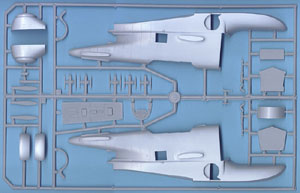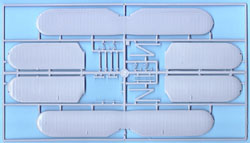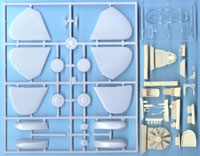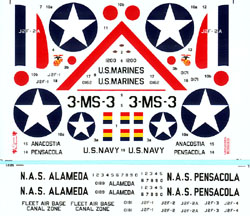Classic Airframes 1/48 Grumman J2F-1/-2/-3/-4 Duck
By Jim Schubert
 |
History
In 1923 Grover Loenings' Loening Aircraft Engineering Corporation of New York city introduced the first of their "Flying Shoehorn" amphibian designs, the COA-1, for the US Army. A few years earlier a young ex naval Aviator, Leroy Grumman, had gone to work for Loening where he honed his engineering and test flying skills developing Loening's fighters and amphibians. In 1928 Loening was bought by Keystone, which, was in turn, bought by Curtiss-Wright. Grumman and others quit rather than leave the East Coast and started Grumman Aircraft Engineering Corporation in Baldwin On Long Island. Their business plan called for doing repair and sub-contract work whilst developing their own design and manufacturing capabilities.
Their first design/production project was an amphibious float package for the Navy's Vought scouts. This work, and Grumman's prior association with the Loening "Flying Shoehorns" led directly, in 1933, to the first Duck, the XJF-1, which looks like a developed Loening. The XJF-1 design was accepted by the Navy in 1933 and, with some minor changes, ordered into production. It quickly evolved through the JF-1, -2 and -3 series. A total of 48 JF series Ducks was delivered to the Navy between May of 1934 and October of 1935.
The first of the J2F series, with which we are here concerned, was delivered to the Navy in April 1936 and the last Grumman built J2F-5 was accepted by the Navy in July of 1941. The main externally visible difference between the -1/-4 series and the -5 & -6 series of Ducks is the chord of the engine cowling. The -5 & -6 also had slightly revised forward fuselage lines behind the engine cowling. Production and design responsibility were turned over to Columbia Aircraft Corporation to free Grumman to work on their more aggressive airplane designs. Altogether Grumman built 303  Ducks for the US Navy, Marines and Coast Guard and 12 for Argentina. The Columbia Duck was designated J2F-6 and was essentially the same as the last -5s from Grumman. Columbia built 330 Ducks between mid 1941 and the end of 1945. The combined total of 645 airplanes was small for wartime, but the distinctive appearance of the Duck has made it more familiar and instantly recognizable than its numbers would seem to warrant.
Ducks for the US Navy, Marines and Coast Guard and 12 for Argentina. The Columbia Duck was designated J2F-6 and was essentially the same as the last -5s from Grumman. Columbia built 330 Ducks between mid 1941 and the end of 1945. The combined total of 645 airplanes was small for wartime, but the distinctive appearance of the Duck has made it more familiar and instantly recognizable than its numbers would seem to warrant.
The Kit
It sure looks like the other Classic Airframes bipes we've seen recently, but this one is a lot bigger; the wing spans 9 3/4" and the overall length is nine inches. This is the first of two Duck kits to be issued by CF. This one can be built as a J2F-1, -2, -3 or -4. The second kit is advertised as being for the J2F-5 and -6. We shall see. My research indicates there were two significant variations in the configuration of the Grumman -5. CF's kit engineer has probably chosen to ignore the early -5 Grumman configuration and design the kit for only the late Grumman -5 and for the Columbia -6. So, be careful when picking a color scheme and don't pick one used only on an early -5.
 The kit engineering is conventional for Czech short run kits, but it still lacks really good engineering. Monogram, Hasegawa, Matchbox and Accurate Miniatures, inter alia, have engineered simple, positive, fitment of the cabane struts on biplane kits to eliminate all the fiddly work usually associated with installation of the top wing. CF have not yet done this. They are getting good enough and their market is getting big enough that if they continue to make biplane kits, and I sure hope they do, they should do something about this to broaden the appeal of their kits to the less skillful modelers who also love "Golden Age" biplanes but are put off by the difficulty of fitting the top wing and by rigging. Similarly, it is time for all the Czech kit makers to provide snug-fitting tabs-and-slots for the installation of wings, tails, &c.
The kit engineering is conventional for Czech short run kits, but it still lacks really good engineering. Monogram, Hasegawa, Matchbox and Accurate Miniatures, inter alia, have engineered simple, positive, fitment of the cabane struts on biplane kits to eliminate all the fiddly work usually associated with installation of the top wing. CF have not yet done this. They are getting good enough and their market is getting big enough that if they continue to make biplane kits, and I sure hope they do, they should do something about this to broaden the appeal of their kits to the less skillful modelers who also love "Golden Age" biplanes but are put off by the difficulty of fitting the top wing and by rigging. Similarly, it is time for all the Czech kit makers to provide snug-fitting tabs-and-slots for the installation of wings, tails, &c.
All 72 of the gray styrene parts are well molded with no sink marks. The four injection molded clear styrene parts are thin, crystal clear and very well done. But here's a beef: The canopy is molded as one piece. For future issues it would be well for CF to issue a canopy molded in separate pieces that have been so sized as to permit the "nesting" required of the individual parts of an opened canopy. As the cockpit is very well detailed it is a shame to have to hide it under a closed canopy.  An obsessed AMSer will, of course, vac-form a couple of canopies, using CF's injection molded piece as a master, and cut them apart as required to open the canopy. The 29 cast resin parts all look pretty good, especially the engine. As usual though, some of the smaller resin parts were broken in my kit.
An obsessed AMSer will, of course, vac-form a couple of canopies, using CF's injection molded piece as a master, and cut them apart as required to open the canopy. The 29 cast resin parts all look pretty good, especially the engine. As usual though, some of the smaller resin parts were broken in my kit.
Accuracy of the kit is very good; all the parts all match, precisely, Paul Matt's excellent 1/48th scale drawings.
One area that concerns me a bit is the strength of the undercarriage. Although CF provide all the little rods that make up much of the landing gear as injection molded parts, the instructions strongly recommend you replace them with styrene rod or stretched sprue. Hey! We're talking strength here. Let's not fool around; let's use brass or aluminum rod or tubing to be sure this thing won't grow weak in the knees in 25 or 30 years (I should live so long!) of sitting on our display shelf gathering dust.
 The Duck is one of those very rare airplanes that seldom appears in photos with the elevator drooping. Whether this was because it had internal control locks or the elevator was very well statically balanced, I don't know. The point of my making this observation is that this plane can be accurately modeled with its elevator in the neutral position whilst sitting statically on the ground. This is not true of most airplanes and is a boon to "Out-of-the-boxers".
The Duck is one of those very rare airplanes that seldom appears in photos with the elevator drooping. Whether this was because it had internal control locks or the elevator was very well statically balanced, I don't know. The point of my making this observation is that this plane can be accurately modeled with its elevator in the neutral position whilst sitting statically on the ground. This is not true of most airplanes and is a boon to "Out-of-the-boxers".
The six sheets of instructions are quite good, giving you everything you expect from professionally planned and executed work, including a rigging diagram. There are three additional sheets of colors/markings information for five different yellow-winged pre-war schemes. The two decal sheets provide all the markings required for the five schemes. These decals are very well printed in perfect register by Microscale.
Conclusion
Ever since I first looked at that misbegotten old, off-scale (~1/54th) J2F-1/-4 Duck from ITC in the 1950's, I've longed for a good kit of the Duck in any scale. None of the many reissues of that ITC kit improved it. The late 1968 1/72nd scale J2F-6 released by Airfix was better. It was accurate, but was cursed with zillions of those golf ball size rivets so loved by Airfix and by lumpy, near-opaque, clear parts.* At Last - here's the Duck kit I've been looking for! And while Classic Airframes kits are not yet in the same league with Tamegawagram, this is a very good kit. It's a bit expensive though; I paid $37.96, post-free, for mine on a pre-order from Squadron Mail Order. Full retail will be about $45. But, to paraphrase Bill Devins, "It's really only expensive if you don't build it."
References
-
Historical Aviation Album, Volume VI: article by Larry Griffin; late J2F-5 drawings by Paul R. Matt
-
Grumman JF Duck - Mini In Action: Timothy Hosek, Squadron Signal
-
Warplanes of the Second World War, Volume 6, Floatplanes: William Green, Doubleday, New York, 1963
-
Skyways - The Journal of the Airplane 1920-1940: Number 10, JF-1 cockpit and mock-up; Number 44, landing gear retraction mechanism
-
Navy Air Colors, Volume 1: Squadron Signal; Duck color schemes - pp 38, 68 and 76
-
IPMS-UK Magazine, May 1969: Duck color schemes.
-
Flight journal Magazine, October 1999: Article, with lots of photos, by Ted Ryder about the J2F-6 owned and flown by the Tillamook naval Air Station Museum in Tillamook on the Pacific coast of Oregon.
